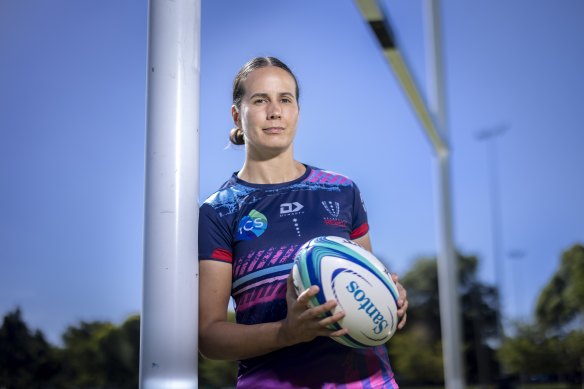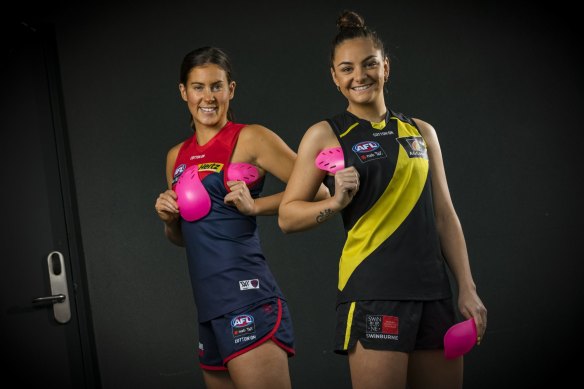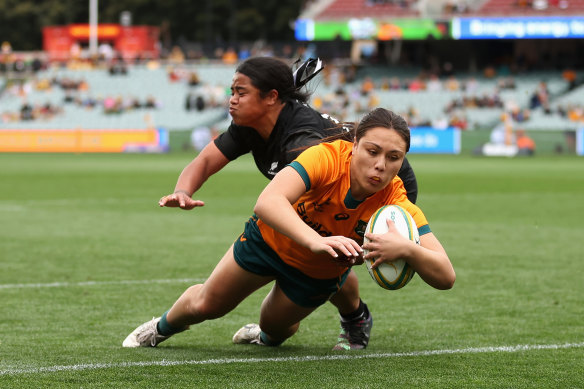World Rugby is funding an Australian landmark study to investigate the cause and impact of breast injuries sustained during matches, taking the lead on how sporting codes tackle the widespread yet little-understood problem affecting women who play contact sport.
Against a backdrop of a historical gender imbalance in sports science research, and as the popularity of women’s leagues soars, the study reflects a shift in how sporting codes are pushing more resources towards female athletes.

Melbourne Rebels player Meretiana Robinson said the study, funded by World Rugby, showed their commitment to developing women’s competitions. Credit:Wayne Taylor
Led by Deirdre McGhee, a breast injuries expert and associate professor at the University of Wollongong, the study, granted by World Rugby late last year, will build upon her previous research to investigate the cause and incidence of breast injuries sustained during training and matches.
“It’s huge – it’s a really, really important big piece, and the first step in the puzzle on breast injuries. It’s an exceptionally important project in the space of women’s rugby as a whole,” science and medical manager for World Rugby Lindsay Starling said.
Set to begin at this coming season of women’s rugby union, researchers will begin data collection to develop guidelines on the prevention, treatment and protection of breast injuries.
Those results captured over two years will inform the development of a classification system for breast injuries, which is set to be rolled out by World Rugby globally – allowing for every competition in the world to have standardised information on the injury.
Aside from breast injuries affecting the performance of players, this classification system is important for the wellbeing of athletes to establish treatment plans.
There is some initial research to suggest a correlation between breast trauma and breast cancer.
Additional studies have also suggested a link between the injuries and breast deformities/asymmetry. There is also the possibility that breast trauma can lead to fat necrosis, which although benign could be linked to resulting chronic pain and anxiety.
Women require their own research
Breast injuries sustained during matches are common, but often unreported across many women’s contact sports in both elite and recreational settings.
A four-year study, conducted by McGhee and published in 2019, investigated breast injuries across women’s contact sport. It found that nearly half of the players in the AFL, rugby league, and rugby union had sustained a breast injury, but only 10 per cent had reported it – even though two in five of those said the injury had affected their performance.
Starling said the current classification system of reporting injuries and surveillance in rugby union – which is standardised globally across the sport – did not include any way of reporting breast injuries, meaning the vast majority were not reported.
“We know that women aren’t just small men, and you can’t just implement the men’s regulations in the women’s game – they are their own people [and require their own research],” Starling said.
“It will firstly help us establish how many and how severe these breast injuries are occurring in Australia, so we can get a picture of the problem. Ultimately, you can’t address a problem and reduce injury if you don’t know how many are occurring in the first instance.”
Across sports, McGhee found female athletes – whom she fondly refers to as “warriors” – are continuing to play despite being injured, affecting their performance on the field.
“They say the pain of their injury distracts them from playing the game. They can’t focus on the game. It’s more difficult to run because it’s more painful to run, and [restricts] movement in their arms,” she said.
‘We don’t even know what constitutes a breast injury’: The scope of the problem
Advancing female sports medicine research has been an uphill battle, and one that researchers say has disproportionately affected the development of female athletes and the professionalisation of women’s competitions.

Back in 2021, Melbourne’s Libby Birch and Richmond’s Monique Conti modelled breast protection armour endorsed by the AFL. Credit:Chris Hopkins
Meretiana Robinson, vice-captain of the Melbourne Rebels Super W team, said it was common among her peers to sustain bruises or bumps on the pitch during matches, but they were rarely reported to physios or team doctors, largely because a lack of education.
“We don’t even know what constitutes a breast injury,” she said.
Robinson said the research project showed World Rugby’s commitment to the development of women’s leagues. “It recognises us as professional athletes, by having that willingness to put that funding behind something [that only affects the women’s league].”
“It’s an exceptionally important project in the space of women’s rugby as a whole.”
World Rugby science and medical manager Linsday Starling
Starling said the project was part of the World Rugby’s commitment to make the game more accessible and base player welfare decisions on evidence.
“The breast injury space in rugby is an area that really not much is known about. We know very little about how breast injury occurs, what they look like, or how big the problem is – but we know they do occur,” she said.
Starling would not disclose the specific amount of funding World Rugby issued for the project, but said it was one of the more expensive projects they had funded through their grant project for independent research. The project started in 2015, and has contributed nearly $2 million in research funding as part of the governing body’s ambition to be the most progressive sport on player welfare.
What are other codes doing?
While World Rugby has taken the lead to fund a project on a global scale, other sporting codes are aware of the problem; the AFL and NRL have implemented educational and awareness training for both players and clinicians about breast injuries recently.
The AFL also confirmed to The Age and Sydney Morning Herald that it is in the process of designing a research proposal alongside the Australian Institute of Sport, to investigate the incidence of breast injuries in Australian rules football.
Robyn Tyler, a masters student at the University of Wollongong, has been surveying current NRLW players and associated staff about the issue since early 2021.

The global landmark study will investigate the cause, prevalence and impact of breast injuries among rugby union players. Credit:Getty
“It’s a purely university-funded study, but we have had wonderful support from the Queensland Rugby League, they’ve booked flights for me to deliver education sessions, and survey staff and players,” she said.
“We would like funding from the NRL to further this because it is based in Queensland at the moment.”
Simon Buxton, the NRL’s elite female performance manager, said the league was supportive of both McGhee and Tyler’s research, but had not made any formal plans to fund or develop a research project.
“It’s hard to get funding for women’s sport – but the more research that can be done, the better,” he said.
Football Australia was contacted for comment.
The answer to the problem, according to McGhee, lies with more research. While preventive measures have been introduced by some sporting codes, including endorsements of protective padding by prominent AFLW players, McGhee said there is no evidence to suggest they are effective.
“We need a multidisciplinary approach to prevention, so we need to look at what strategies we can use to prevent injuries,” she said. “That needs to involve athletes, coaches, researchers like myself, clinicians and sporting organisations.”
Most Viewed in Sport
"breast" - Google News
March 22, 2023 at 01:30AM
https://ift.tt/uKqr76a
‘You can’t just implement the men’s regulations in the women’s game’: World Rugby funds landmark study into breast injuries - Sydney Morning Herald
"breast" - Google News
https://ift.tt/Rkn50qz
https://ift.tt/TP9fvEo
Bagikan Berita Ini














0 Response to "‘You can’t just implement the men’s regulations in the women’s game’: World Rugby funds landmark study into breast injuries - Sydney Morning Herald"
Post a Comment